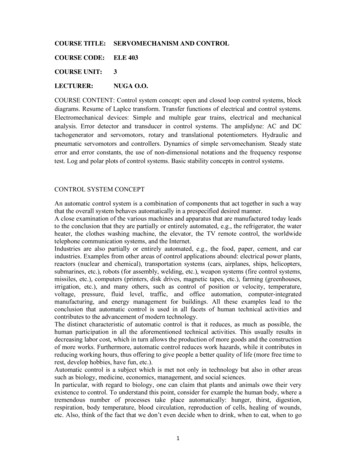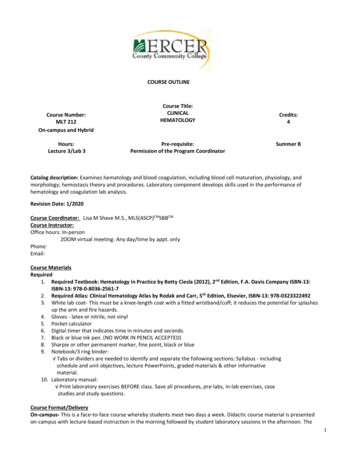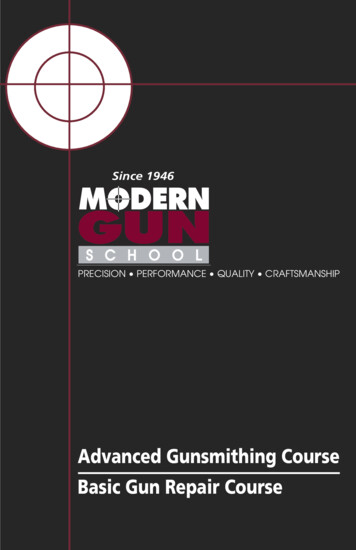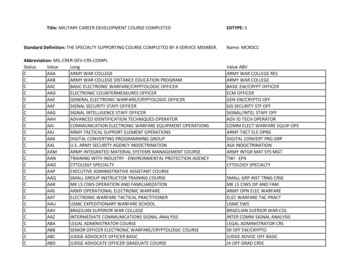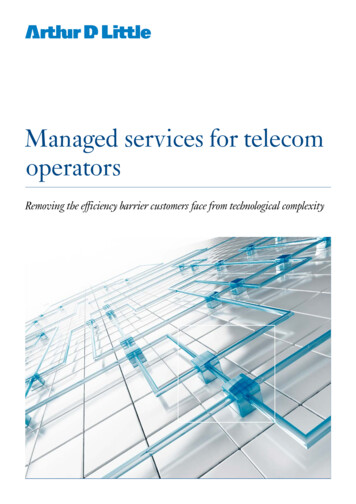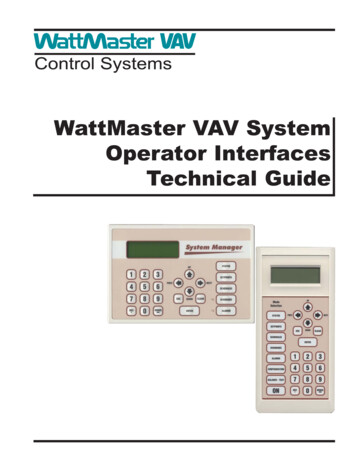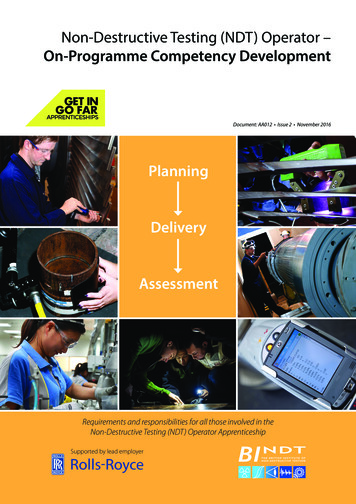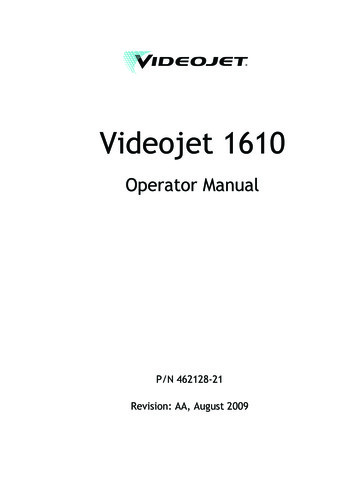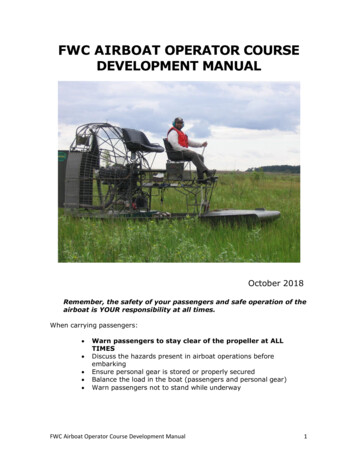
Transcription
FWC AIRBOAT OPERATOR COURSEDEVELOPMENT MANUALOctober 2018Remember, the safety of your passengers and safe operation of theairboat is YOUR responsibility at all times.When carrying passengers: Warn passengers to stay clear of the propeller at ALLTIMESDiscuss the hazards present in airboat operations beforeembarkingEnsure personal gear is stored or properly securedBalance the load in the boat (passengers and personal gear)Warn passengers not to stand while underwayFWC Airboat Operator Course Development Manual1
Table of ContentsPurpose.4Course Objectives .4Disclaimer .4Chapter 1- Airboat OrientationIntroduction .5Components of an Airboat .6Hull Design. 13Hull Materials. 13Chapter 2-MaintenanceEngine Types . 14Aircraft . 14Automotive . 15Propeller Maintenance . 16Pressure Plate. 19Reduction Gear Box . 20Running Gear and Engine Frame . 21Steering Linkage and Rudders . 21Electrical System. 22Lights . 23Exhaust System . 24Cooling System. 24Trailer Maintenance . 25Trouble Shooting . 26Maintenance Log . 27Skill Development . 27Ending Notes on Maintenance . 28Chapter 3- Required and Recommended EquipmentRequired Safety Equipment . 29Recommended Safety Equipment . 29Other Recommended Equipment .29Recommended Spare Parts . 30Other Recommended Items . 30Chapter 4- Operating AirboatsOperator Attitudes and Awareness . 32Pre-Flight Safety Inspection . 34Cold Starting an Engine . 37Engine Warm-Up. 38Trailering, Towing and Launching . 39Dry Launching and Retrieving . 41Weight Distribution and Cargo. 43Normal Running . 43Stopping and Slowing Down. 44FWC Airboat Operator Course Development Manual2
Execution of Turns. 44Counteracting Inertia and Maintaining Control in Turns . 46Shallow Water Operations . 46Deep Water Operations . 47Dry Ground Operations . 48Crossing Levees . 49Night Operations . 50Collision Avoidance . 51Obstacles to Avoid. 52Getting Stuck and Unstuck . 54Swamping and Sinking . 55Encountering Other Airboats . 56Wind . 56Lost or Simply Turned Around . 57Knowledge of the Terrain . 57Storm Debris . 58Considerations for Off-Trail Use . 58Operation of Airboats Around Lightning . 59Chapter 5- Practical ExercisesLaunching . 60Loading . 60Docking . 60Shallow Water Course . 61Deep Water Course . 63Docking and Beaching . 65Safety Precautions . 67Pre-Flight Safety Inspection Checklist . 69Float Plan . 71Airboat Operation Log . 72Example Maintenance Log . 75Glossary of Airboat Terms . 76FWC Airboat Operator Course Development Manual3
PurposeThis is an entry-level course on airboat operation. Airboats are dangerous and canpresent serious, life-threatening situations at unexpected times to even theexperienced of operators.The airboat is a specialized piece of equipment designed to go where other vesselscannot go. Operating the controls of an airboat is very simple, it just requiresthrottle and a steering lever, however, intricacies of operating an airboat correctlyare complicated and extremely critical.Course ObjectivesBy the end of the airboat operator course, the participant should be able to:1. Describe the operating principles of an airboat2. Identify the control panel and the purpose of each gauge with respect to aircraftand automotive engines3. Identify each part of an airboat4. Conduct a thorough pre-flight safety inspection5. Perform minimal required maintenance of airboat components6. Demonstrate how to safely start, stop and turn an airboat in shallow and deepwater as well as in semi-dry conditions7. Demonstrate minimum planing speeds8. Demonstrate docking, beaching, loading and unloading an airboatDisclaimerNeither the authors, advisors, nor the agencies they represent can assume anyliability for accidents arising from the presentation of this training material. Thereare far too many conditions, variables and situations, while operating airboats, tobe adequately covered in this basic training module.Photo ContributorsBrett Billings, Axle Brunst, Amanda Chestnutt, Ryan Hagerty, Steve Hillebrand,Gary Hill, Michael Lusk, Jena Moon, Mike Nance, Ian Shive, Ellen Stutzenbaker,Patrick Walther, American Airboats, Mark's Airboats, Stossel Airboats, KlineAirboats, and Southern Airboats.FWC Airboat Operator Course Development Manual4
Chapter 1-Airboat OrientationIntroductionAirboats are uniquely designed for haulingequipment and people in shallow water areas suchas wetlands, swamps, marsh areas, vegetationchoked waterways or semi-dry conditions. Airboatsare generally flat-bottomed; aluminum, fiberglassor ABS plastic hull vessels varying from 8–30 feetin length and from 3–15 feet in width with payloadcapacities up to 7,500 pounds. They are usuallylacking floatation material and most are not U.S.Coast Guard approved. The bottom may bestainless steel, aluminum or covered by aprotective layer of polymer or polyethylene whichreduces friction, allowing the boat to be driven inshallow water, through swamps, over gravel orsand bars and onto the shore.The engine and propeller are housed at the rear of the boat in a protective cage oftubing and covered in wire mesh. The propellers are either laminated wood orcarbon fiber and vary in length from 58” to 90”. The large metal rudders mountedon the cage provide steering. These vessels usually weigh from 2,300 to 3,900pounds.Airboats may be powered by either automotive engines (usually 350–502 cubicinch) or aircraft engines (4-6 cylinder Lycoming or Continental) producing 150 toover 300 hp. There are a variety of advantages and disadvantages of each enginetype that will be discussed throughout this manual.Airboats are a unique specialty craft falling in a category between motorboats andairplanes. The vessel is powered by moving air across the propeller blades andguided by controlling the rudders. The propeller is a lifting surface similar to anairplane wing. As the propeller rotates through the air, lift is produced which pullsthe propeller forward. This forward thrust is transmitted through the shaft andpower train to the engine or “thrust-bearing.” From there the force is transmitted tothe hull of the boat. The operator controls the speed of the forward thrust with theaccelerator pedal. There is no reverse and there are no brakes.Airboats are a very high maintenance vessel. Aircraft engines can seem finicky andmysterious at times. However, aircraft powered boats have the advantage of beinglighter weight, more maneuverable and have a greater initial thrust thanautomotive engine powered boats when used in shallow and marshy areas. Manyfield stations currently purchase automotive engines because they are easier andless expensive to service. Automotive fuel is more readily available than aviationFWC Airboat Operator Course Development Manual5
fuel and because automotive engines are bulkier with heavy hulls, they are morestable in deeper water. They also have greater cargo capacity and have morepower in dry conditions. Automotive engines are simpler, but have some quirkssuch as dieseling and overheating.Components of the Airboat123456-RudderPropellerCageMotorCooling SystemSteering ControlFWC Airboat Operator Course Development Manual7- Running Gear8- Exhaust9- Fuel Tank10- Operator’s Platform11- Reinforced hull12- Battery6
1) Rudders Are the “steering wheel” for theairboat. Typically are light-weight aluminum,hollow inside. Connected to the airboat at thetransom and cage by linkages.o Push-pull cableo Heim ball-joint linkageso Drag link rods Usually, contain the ONLYFLOATATION in an airboat “Tracking” can be accomplished byaddition of “trim fins”.2) Fan or Propeller The airboat is pushed forward by thepropeller, which produces a rearwardcolumn of air behind it. Comes in variety of set ups fromsimple 2 bladed propellers to severalsmaller propellers often used in aseries of counter rotating propellers. Made in a variety of materials andsizes. Common materials used for propellersare wood and synthetic material. Synthetic propellers are generallyhollow, lighter weight, and require lessmaintenance.3) Cage Protects the engine and propeller from debris. Protects the operator and crew from engine and propeller. Houses the engine, engine stand, fuel tank, batteries and othercomponents. Usually covered by 2” x 4” galvanized or stainless wire mesh, spot weldedin place over the cage frame. Often allows access to engine oil and coolant areas for ease in checkingand adding fluids.FWC Airboat Operator Course Development Manual7
4) MotorThere are two common types of engines used in airboats- aircraft enginesand automotive engines.Aircraft Engines Available in 4 or 6 cylinder modelsfor power requirements. Lighter weight than automotiveengines. Typically produce a higher powercurve than automotive engines. Much more expensive to purchase Parts are more expensive and oftendifficult to obtain. Often produce overheatingsituations due to lack of airflow/cooling. Often require specialized mechanicsto provide mechanical repairs. Adaptable to wooden and compositepropeller variations. Runs BEST on aviation (AV-GAS)fuel. Requires special aviation oil for internal lubrication Offers redundant features for reliability in starting. magnetos dual s
airplane wing. As the propeller rotates through the air, lift is produced which pulls the propeller forward. This forward thrust is transmitted through the shaft and power train to the engine or “thrust-bearing.” From there the force is transmitted to the hull of the boat. The operator controls the speed of the forward thrust with the


